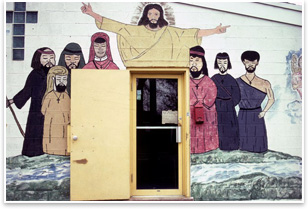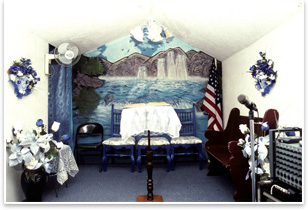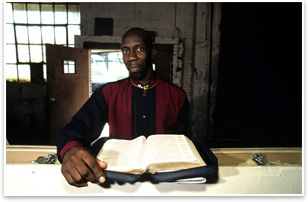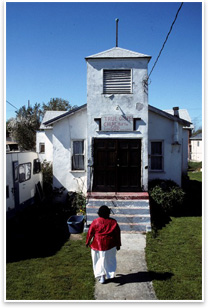
| Photographs of Storefront Churches Displayed at the National Building Museum Camilo José Vergara exhibit runs through November 29 How do you . . . depict an important aspect of community building in inner city architecture? Summary: Photographer Camilo José Vergara’s exhibit Storefront Churches: Photographs by Camilo José Vergara is on display at the National Building Museum in Washington, D.C., till November 29. In his photographs, Vergara, born in Chile, documents inner-city structures—many of which are decidedly secular—that have been converted into places of worship. 
Garfield Blvd, Chicago, Illinois, 1992. Photo © Camilo José Vergara, courtesy National Building Museum. In Storefront Churches: Photographs by Camilo José Vergara, photographer, author, and 2002 MacArthur Fellow Camilo José Vergara displays his 30-year exploration of places of worship in poor urban neighborhoods in U.S. cities such as Chicago, Detroit, Los Angeles, and New York. The exhibition includes 84 framed color photographs, with more than 100 time-lapsed slide show images. Storefront buildings include banks, an appliance warehouse, a furniture store, a fast-food franchise, a movie theater, a car dealership, homes, and garages. There are images of outdoor worship places—such as one picture of a circled sanctuary in a park with a few seats and pews and one cross—and one photograph of an outdoor inflatable church. The names of the churches are related to different types of ministries. Worship prevails 
439 Concord, Bronx, New York, 2004. Una Luz en el Camino, mural by Hermano Peralta. Photo © Camilo José Vergara, courtesy National Building Museum. Vergara says his photography captures the transformation of older cities. “Those places have lots of churches,” he explains. “I’m always faced with how to present my work. One way is to try to present the whole thing, but that is unwieldy—where are you going to show everything? So what I have been doing is showing certain aspects or certain places.” Vergara says that for his first book, Silent Cities: The Evolution of the American Cemetery, published in 1989, he tried to “comprise everything.” He later narrowed his focus for Unexpected Chicagoland in 2001 and How the Other Half Worships in 2005. National Building Museum curator Chrysanthe Broikos worked with Vergara on the exhibit and notes: “His subject is the landscape of poverty in America. When he began photographing, one of the first things he noticed was an abundant of churches in poor neighborhoods. In 2002 he used the $500,000 of the MacArthur prize to focus on this subset. In 2005, How the Other Half Worships came out. He is compelled to take these pictures. He is usually not commissioned, except when he receives grants. In a sense, we subsidize his work.” 
Anthony Ray, the Greater Temple of Praise, Brooklyn, New York, 2002. Photo © Camilo José Vergara, courtesy National Building Museum. Pictures tell church, community stories He would also use the phone book and Internet to find some of what he says are thousands of storefront churches. “What defines the area is poverty and segregation,” he adds. “If you walk or drive down any commercial street, you will find them.” Vergara notes that storefront churches arise as result of what a community has and what the city allows. 
1855 3rd St., N. Richmond, Calif. 2004. Photo © Camilo José Vergara, courtesy National Building Museum. Broikos says Vergara became known for going back to the same neighborhoods over time. “Vergara started out wanting to photograph urban poverty,” she says, “but by the late 70s he realized that by focusing on the built environment he could see the physical changes.” There is a display of a sequence of photographs showing a church, once a movie theater, from 1981 to 2009, where both the storefront church and its adjacent structures have changed. Over time, one adjacent structure transforms from a chicken eatery to a steak place to a tire shop. Eventually, the adjacent structures on both sides of the storefront church are demolished. The exterior of the storefront church also changes, as well as the church name. “As much as the building changes, you can see how the neighborhood actually transforms,” Broikos says. “There is a whole lot more going on where this church is then just the changing of just its physical aspects.” Also on display are pictures of two abandoned inner city churches, and one functioning church in Detroit. Says Broikos, “Part of the story is, ‘What have traditional churches done to reach out to the new communities?’ We wanted to show that one of the reasons a lot these urban churches arise is because no one is serving that population.” There are also photographs on display of church congregants and elders, street evangelists, church art work and statues, and church signage. One church sign declares, ‘When Everything Fails Try Prayer.” Broikos says that the concept of storefront churches is similar to that of the corner store. There can be up to four churches on the same block, she points out, each catering to a different community. “Vergara realized there was no dearth of churches,” she notes. “He felt that you can learn something about urban neighborhoods by looking at the churches.” |
||
Copyright 2009 The American Institute of Architects. All rights reserved. Home Page |
||
news headlines
practice
business
design
recent related
› Worship Centers Create Town Center Atmosphere
› Knitting the City Back Together from Gray and Brown, with Green
In conjunction with the Storefront Churches exhibition, Vergara is participating in the Museum’s summer outreach program, Investigating Where We Live (IWWL), which empowers middle and high school students to explore and interpret city neighborhoods through photography, interviews, and creative writing. Now in its 14th year, IWWL was inspired by Vergara’s 1996 exhibition at the museum, The New American Ghetto: Photographs by Camilo José Vergara. Vergara will also give a public lecture this November on his work in conjunction with FotoWeek DC 2009.
The National Building Museum is also presenting Form and Movement: Photographs by Philip Trager. The exhibition consists of black and white photographs selected from Trager’s 40-year career and brings together images of early New England landscapes, architecture from Italian Renaissance villas, New York City skyscrapers, and modern dance.
If you go …
Storefront Churches: Photographs by Camilo José Vergara is at the National Building Museum [http://www.nbm.org], 401 F Street NW, Washington, D.C.; 202-272-2448. The museum is open to the public Monday through Saturday, from 10 a.m. to 5 p.m., and Sunday, from 11 a.m. to 5 p.m. Admission is free, with a $5 donation suggested.

